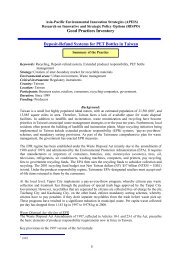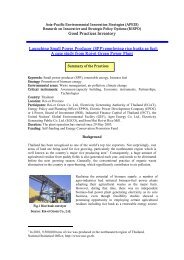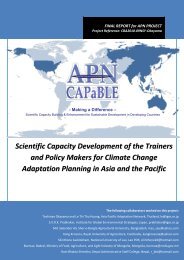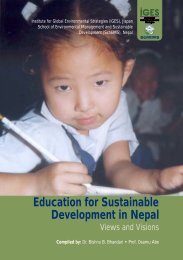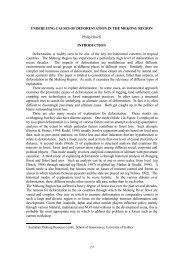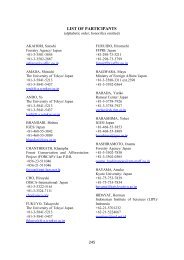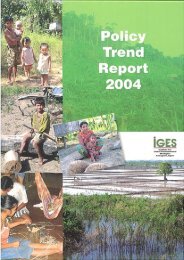final evaluation report akk_iges_final.pdf - IGES EnviroScope
final evaluation report akk_iges_final.pdf - IGES EnviroScope
final evaluation report akk_iges_final.pdf - IGES EnviroScope
You also want an ePaper? Increase the reach of your titles
YUMPU automatically turns print PDFs into web optimized ePapers that Google loves.
AKK-<strong>IGES</strong> New Climate Risk Management Project<br />
displayed positive anomaly (i.e., higher rainfall than the average), which now shows negative<br />
anomaly (i.e., lower than the average) in the recent decade 2000-09. It has also been observed that, as<br />
compared to 1970-60, there is a considerable increase (10-15%) of September rainfall in the recent<br />
decade. All other monthly deviations are noticeable.<br />
Upazilla<br />
Condition<br />
Area<br />
(Km 2 )<br />
Table 1. Climate change impact on monsoon flooding in Faridpur<br />
Average<br />
Flood<br />
Climate<br />
change<br />
condition<br />
Inundated area (>= 0.3m) (km 2 )<br />
%<br />
increase<br />
due to<br />
CC<br />
Medium<br />
Flood<br />
2004<br />
Climate<br />
change<br />
condition<br />
%<br />
increase<br />
due to<br />
CC<br />
Faridpur 2072.72 643.3 723.5 12.47 955.5 1084.6 13.51<br />
Source: Extracted from Table 6.1, Government of Bangladesh, 2008<br />
Agricultural crops of Faridpur are influenced by seasonal characteristics and different variables of<br />
climate such as temperature, rainfall, humidity, day-length etc. It is also often constrained by different<br />
disasters such as floods, droughts, and cyclones. The higher temperatures and changing rainfall<br />
patterns coupled with increased flooding, droughts in the central, and flooding in rainy season and<br />
drought in summer are likely to reduce crop yields and crop production. IPCC estimates that, by 2050,<br />
rice production in Bangladesh could decline by 8 percent and wheat by 32 percent (IPCC, 2007).<br />
Climate change has both negative and positive impacts on fisheries. The positive impact is the<br />
possible increase in the open water fisheries during flood. It appears that the impacts would not be<br />
remarkable in national context rather it would affect investment at individual level. It is revealed that<br />
flood and cyclone affect culture fisheries severely while the effect of other shocks such as drought,<br />
erratic rainfall, heat wave, cold wave, fogginess is low to moderate. Flood causes fish loss damaging<br />
pond dykes, hatcheries, nurseries and embankments. Fish production may also be hampered by<br />
affecting breeding ground of fish due to siltation of fish habitat. These affect the livelihoods of<br />
fishermen and fish farmers. It is revealed that extreme temperature and climate change related natural<br />
disasters would affect livestock significantly. High temperature would affect livestock in a number of<br />
ways: it causes great discomfort as in the case of human, decreases feed intake and alters nutrient<br />
metabolism leading to high loss of energy.<br />
Therefore, some atmospheric and climatic changes in the hydro-meteorological system in the Ganges-<br />
Brahmaputra basin system in Bangladesh are very distinct. These findings show that the variations of<br />
total seasonal rainfall, the timing of onset, peak, and recession, are changing considerably at a<br />
dramatic pace. These changes could have important implications for Faridpur district which is located<br />
on the course of the river Padma. Hence, there is a need for the Faridpur district to be prepared for the<br />
future climate change impacts in a planned manner.



